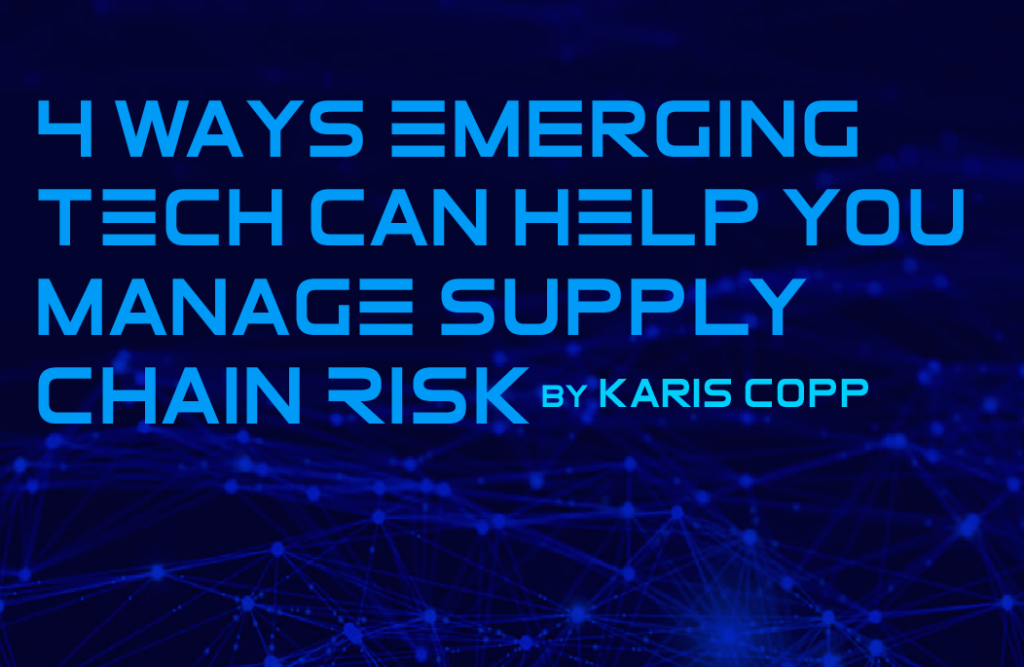I didn’t plan on writing something that adds to the coronavirus information overload, but unfortunately, it continues to be at the forefront of my mind both personally and professionally, whether I like it or not! From a business perspective, there’s no doubt that COVID-19 is wreaking havoc around the world. Axios reports almost three-quarters of US companies are experiencing supply chain disruptions, and a number of businesses are already pricing in revenue losses for the year.

For some small businesses, the effects of the virus will be catastrophic, as they struggle to contend with longer lead times, slowing demand, sick or quarantined employees, among other factors. One positive outcome of the coronavirus turmoil could be businesses re-evaluating their value chains and not only improving on areas of weakness but planning thoroughly for when disaster next strikes (which will hopefully be a long way off!). In this blog, I’ll be looking at three ways in which emerging technology can help mitigate supply chain risk.
3D Printing
Our dependence on global supply chains leaves businesses vulnerable in circumstances such as these. For smaller businesses, managing fluctuations in demand can be a real challenge, as they typically don’t have the flexibility to react in the same way larger companies might be able to. 3D printing, or additive manufacturing, presents an opportunity for businesses to produce product components on-demand. Physical inventory becomes digital files stored in a ‘virtual warehouse’, and are 3D printed when required. Of course, the challenges aren’t eliminated entirely as the raw materials are still required, but it certainly reduces a number of supply chain touchpoints and allows for a more flexible approach.
IoT
The Internet of Things (IoT) can offer a fantastic boost to supply chain visibility. IoT sensors and devices track and monitor goods to provide real-time data on aspects like the product’s condition and the external environment, continuously updating everyone involved in the supply chain and allowing them to proactively address any challenges. The coronavirus has caused a great deal of demand uncertainty, so implementing IoT devices to track and update inventory could save some headaches in the event of a future pandemic or similar disaster.
Artificial Intelligence
Artificial intelligence (AI) and predictive analytics will greatly enhance the ability to accurately forecast demand through the analysis of large volumes of data. AI will mean supply chain risk factors will be easily measured and tracked, so disruptions can be predicted and businesses can respond to challenges ahead of time. This predictive decision-making can positively impact a myriad of supply chain touchpoints, such as production planning, inventory management, warehouse operations, and logistics.
Blockchain
Supply chain risk management makes a great use case for blockchain. Blockchain is an immutable ledger, using cryptographically recorded data held in digital ledgers, and is therefore ideal for the fight against counterfeiting, detecting contamination, anticipating delays, and catching payment errors. As everyone has access to all transactions or ‘blocks’ along the chain, and any updates are automatically visible for all parties, this can have a massive impact on efficiency, traceability, and data accuracy.
A doom and gloom topic perhaps, but to me, it’s an example of how technology can have a positive impact on our lives. We may not be able to predict the future, and unfortunately, the power to control natural disasters, economic crises, or viral pandemics is out of our hands, but through the smart implementation of technology we can do everything in our power to maintain a 360-degree overview of operations, anticipate challenges, and respond with agility and efficiency. Stay healthy out there!
 Karis Copp is a UK-based writer, journalist and communications expert. With a background as an editor and public relations specialist in the print industry, she now works on a freelance basis covering events, writing on industry news and trends, and working with businesses to help them tell their stories and connect with their customers. Follow her on Twitter @KarisCoppWrites.
Karis Copp is a UK-based writer, journalist and communications expert. With a background as an editor and public relations specialist in the print industry, she now works on a freelance basis covering events, writing on industry news and trends, and working with businesses to help them tell their stories and connect with their customers. Follow her on Twitter @KarisCoppWrites.













